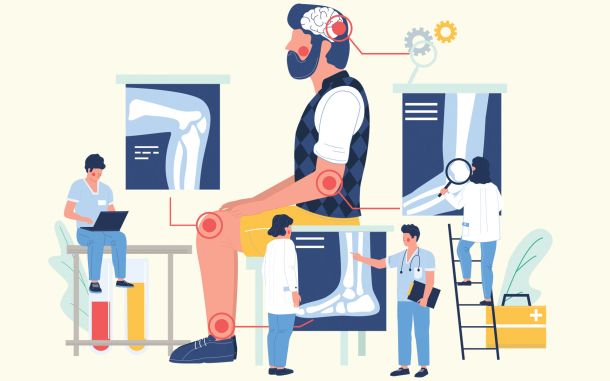Physiological Effects of Music

In This Article
-
Music therapy is an independent specialty of modern medicine and has been used since antiquity. In Islamic civilization, Sufis mentioned the use of music in the treatment of mental and neurological disorders.
-
Music can lower respiration, heart rate, and body temperature; stabilize blood pressure and cerebral blood flow; and lead to deep relaxation and enhanced quality of life.
-
Newborn babies, especially premature ones, benefit the most from music in terms of stress reduction, pain detection, and hearing improvement.
Sound is created by fluctuations in air pressure caused by a vibrating source that stimulates hearing in humans. We produce sound with the help of organs such as the vocal cords, lungs, and muscles. Humans speak using sounds at the limited frequencies they can perceive (20 Hz-20 kHz).
Music is defined as the artistic expression of emotions, thoughts, and symbols in one or many voices. Scientists have established music’s positive or negative effects on the human body in all conditions and environments and determined that our body reacts differently to various types of music and sound. The nature of this effect may vary depending on parameters such as the emotional state of the person, time, and place.
Music therapy is an independent specialty of modern medicine and has been used since antiquity. In Islamic civilization, Sufis mentioned the use of music in the treatment of mental and neurological disorders, and scholars like al-Farabi (d. 950) and Ibn Sina (d. 1037) defined the principles of music in treatment.
According to scientists, music can not only be used effectively in the treatment of diseases—it can also be deployed as a shield against psychological problems such as stress and intense anxiety by selecting the appropriate rhythm, sound, and musical genres. Recent years have witnessed several studies on the psychological and physiological effects of music on humans [1]. According to these studies, music affects the human brain at an anatomically measurable level; this explains how music can change a society's understanding of culture and art [2].
By altering the levels of mood-affecting hormones such as serotonin, dopamine, adrenaline, testosterone, and serotonin, music can lower respiration, heart rate, and body temperature; stabilize blood pressure and cerebral blood flow; and lead to deep relaxation and enhanced quality of life [3]. It reduces anxiety and nausea and alleviates insomnia by diverting patients’ attention to other activities. Music also plays an important role in improving the quality of life of end-stage cancer patients [4]. The positive effects of music on pain and anxiety are prominent.
Which area of the brain perceives music?
It is crucial to be familiar with the relevant musical terminology to have a better understanding of this matter. Timbre is the characteristic that distinguishes the sound produced by the vibration of an object from the sound produced by a different object at the same height. Rhythm is the harmony of sound resulting from the repetition of stress, length, or sound features and stops in a verse or a note. Melody is a sequence of sounds created in line with a certain rule.
These sounds are processed in different regions of the brain that are separate but close to one another. Damage to these areas, through trauma or similar reasons, may complicate hearing or distinguishing the relevant sound. For instance, damage to the auditory cortex in the right temporal region may result in the inability to keep a regular tempo, while damage to the cerebellum and basal ganglia may result in impaired rhythm perception and inability to produce rhythm. While rhythm is detected in the motor area, timbre is sensed in the auditory area. The right hemisphere of the brain has better frequency resolution, which is crucial for processing precision. Meanwhile, the left hemisphere has better temporal resolution, which is imperative for speech analysis.
Timbres activate the right auditory cortex, whereas rehearsing music stimulates the dorsolateral and inferior frontal cortex. Melodies are typified abstractly in the brain while emotional melodies activate the fronto-occipital region of our brain. The superior temporal cortex detects the instrument and speed changes. Our secondary auditory cortex is activated when we visualize music; listening to a favorite piece of music activates a different sensory area [5].
In temporal lobe disorders, some may lose certain musical abilities such as playing and identifying melodies, singing, and following rhythm. For instance, Maurice Ravel, one of the greatest composers of the 20th century, could listen to pieces of music but could no longer compose after cerebral palsy affected the left hemisphere of the brain.
Effects of noise on human physiology
Noise is the common name for meaningless and unpleasant sounds that have an adverse effect on people. While some may hear sounds as music, others may hear them as noise. The threshold of discomfort varies from person to person.
The effects of noise on human physiology are divided into short-term effects that disappear with the cessation of noise and long-term effects that can last for hours or even days. In most people, noise causes short-term effects such as stress, changes in heart rate, respiratory rate and blood circulation, muscle spasms, startles, and insomnia. These side effects are felt more acutely during sleep, with automatic reactions to sudden and loud noises. In addition, gastritis, ulcers, high cholesterol, hypertension, and migraine disorders are common long-term effects of noise. Even in cases where people think they are accustomed to noise, these side effects cannot be inhibited [6].
Exposure to intense and loud music, defined as music intoxication, increases the height of alpha waves in brain electrical activity. This situation varies from person to person, but as reported in some people even toxic doses can be considered normal. This explains why music is perceived and processed differently by different people, and while in the same person, character and music perception show parallelism.
Musicogenic epilepsy
Current technological developments have expanded our access to all kinds of music. Studies have shown some disorders can be triggered in line with the type and volume of music listened to. Epilepsy tops the list of these disorders. It is well known that exposure to sunlight or flashing or flickering lights in the 16-25 Hz range can trigger epileptic seizures. While some patients made to listen to music during a seizure benefited from the music and their seizures ceased, others’ seizures deteriorated [7]. The reason for this bidirectional effect of music on epileptic attacks is not yet fully understood.
Musicogenic epilepsy, where epileptic seizures are triggered by music, is a rare form of epilepsy, first defined in 1937. The French composer Berlioz, who contributed significantly to the composition of the modern orchestra, suffered from musicogenic seizures. Affecting one in a million people, these seizures are often triggered by listening to or playing music, or by its inspiration or conception. It has even been shown that some patients’ seizures can be triggered by the type of music, instrument, or composer they listen to. Church bells, the melody of La Marseillaise (the national anthem of France), some hymns, and even some songs sung in a low, muffled, or metallic voice have been shown to trigger such seizures [8]. Experts say the therapeutic efficacy of music can be demarcated by understanding the mechanism.
Musical pharmacology
Musical pharmacology is when, after a diagnosis, various kinds of music protocols are uploaded to digital tablet device and sent to the patient’s home. Analyzing the music pieces the patient prefers to listen to, the active parts are extracted and blended into balanced medical compounds. The most common areas where such medical compounds are used include psychosomatic disorders, pain, anxiety, depression, insomnia, and certain cardiac arrhythmias [9].
Studies examining the effects of music therapy during pregnancy suggest that nurses and midwives providing maternity care would be wise to take advantage of the positive effects of music. In pregnant women with pre-eclampsia, music can help keep fetal movement and heart rate at normal levels by lowering blood pressure [10].
Newborn babies, especially premature ones, benefit the most from music in terms of stress reduction, pain detection, and hearing improvement [11]. This notion is supported by the common practice of singing lullabies to calm crying babies or babies who have trouble falling asleep, or singing prayers, for instance the call to prayer (adhan) in Muslim cultures, often achieving the desired result.
A study in Japan has shown fetuses feel their mothers’ reaction to noise, and that noise increases the incidence of low-birth-weight babies. The human cochlea, an important component of hearing, completes its development by 24 weeks of gestation, and by 26 weeks, the fetus can respond to sound stimuli. By the 35th week of gestation, the fetus can distinguish between sounds with a frequency of 250-500 Hz and between the sounds, “baa” and “bee.” This shows that babies’ sense of hearing develops significantly before birth [12].
As seen, human interest in music and sound begins in the womb and continues over a lifetime. When we listen to a piece of music that suits our mood, we unconsciously follow the rhythm with our brain waves, heart rhythm, breathing and emotional state. Each person reacts differently to music and sound. This is due to the two-way effect of music. People like or dislike music based on the effects it has on the body. This is an individual response, based in part on our anatomical, physiological, and psychological functions.
During speech, Broca’s and Wernicke’s areas in the left hemisphere of the brain are mentally active. It is believed these areas may have another feature representing feelings and emotions. This feature perceives the emotional components of speech, including melody, intonation and gestures. Voices, words, gestures and facial expressions move humans indiscriminately. Likewise, reciting prayers with a beautiful voice and its impacts on the human nervous and endocrine physiology is a subject for further research.
We can liken the human organism to a unique work of art and an ensemble of tunable, delicate instruments [13]. Everyone should discover the music and rhythms in sync with the physiology of their own body, and not tune their body to random types of music and sounds. Hence, it would be wise to manage our body like a conscious conductor. It is essential to find the music that suits our nature.
References
- F. S. Ünal, “Müzigin ses olarak insana fizyolojik etkisi”, Kültür Evreni Dergisi, 6(22), 2014, s. 118–125, www.kulturevreni.com/22-118.pdf.
- S. A. Azizi, “Brain to music to brain!”, Neuroscience Letters,459, 2009, s. 1–2.
- N. Karamizrak, “Ses ve Müzigin Organlari Iyilestirici Etkisi”, Kosuyolu Heart Journal, 17(1), 2014, s. 54–57.
- H. Covington, “Therapeutic music for patients with psychiatric disorders”, Holist Nurs Pract, 15, 2001, s. 59–69.
- A. J. Blood ve R. J. Zatorre, “Intensely pleasurable responses to music correlate with activity in brain regions implicated in reward and emotion”, Proc Natl Acad Sci US, 98(20), 2001, s. 11818–11823.
- MEB. Gürültünün Etkileri. Ankara: Millî Egitim Bakanligi, Aile ve Tüketici Hizmetleri, 2012, s. 1–25.
- A. T. Berg ve ark. “Revised terminology and concepts for organization of seizures and epilepsies: report of the ILAE Commission on Classification and Terminology”, 2005–2009; Epilepsia, 51, 2010, s. 676–685.
- S. E. Brien ve T. J. Murray, “Musicogenic epilepsy”, Can Med Assoc J, 13, 1984, s. 1255–1258.
- I. Ün, “Farmakoloji ile müzik arasinda olasi etkilesimlerin arastirilmasi”, Lokman Hekim Dergisi, 6(3), 2016, s. 159–164.
- E. Toker ve N. Kömürcü, “Effect of Turkish classical music on prenatal anxiety and satisfaction: A randomized controlled trial in pregnant women with pre-eclampsia”, Complementary Therapies in Medicine, 30, 2017, s. 1–9.
- J. Loewy ve ark. “Sleep/sedation in children undergoing EEG testing: a comparison of chloral hydrate and music therapy”, Am J Electroneurodiagnostic Technol, 46(4), 2006, s. 343–355.
- S. E. Trehub, “The developmental origins of musicality”, Nat Neurosci, 6(7), 2003, s. 669–673.
- D. Campbell, Mozart Etkisi, Istanbul: Kuraldisi Yayincilik, 2002, s. 156–343.









